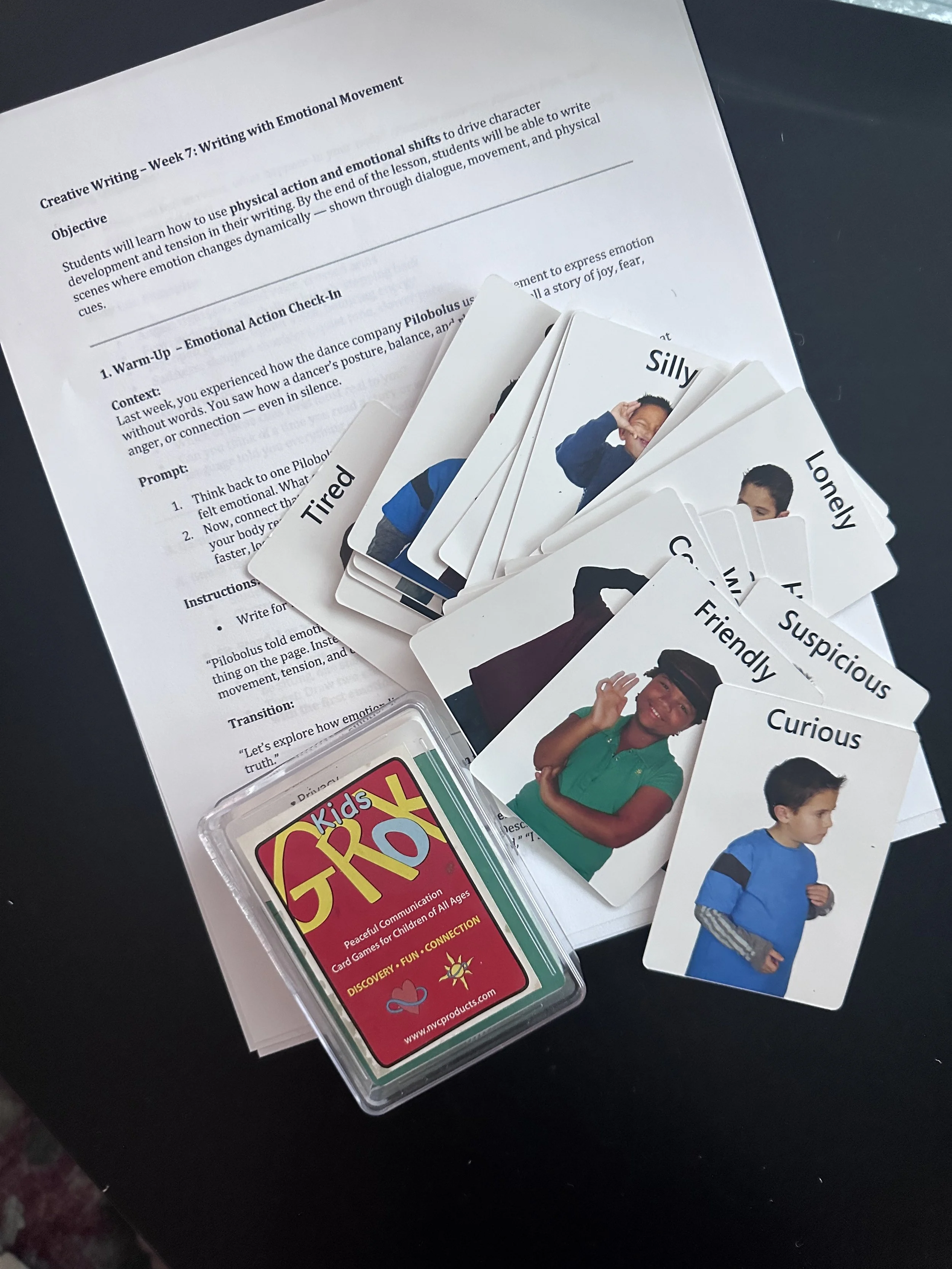Creative Writing – Week 7: Writing with Emotional Movement
Creative Writing – Week 7: Writing with Emotional Movement
Objective
Students will learn how to use physical action and emotional shifts to drive character development and tension in their writing. By the end of the lesson, students will be able to write scenes where emotion changes dynamically — shown through dialogue, movement, and physical cues.
1. Warm-Up – Emotional Action Check-In
Context:
Last week, you experienced how the dance company Pilobolus uses movement to express emotion without words. You saw how a dancer’s posture, balance, and rhythm can tell a story of joy, fear, anger, or connection — even in silence.
Prompt:
Think back to one Pilobolus moment that stood out to you — a shape, lift, or gesture that felt emotional. What emotion did you sense? How did the dancers’ bodies show it?
Now, connect that to your own life: write about a time you felt that same emotion and how your body reacted. What did you do physically — stand taller, curl in, freeze, fidget, move faster, look away?
Instructions:
Write for 3–4 minutes, focusing on the physical response, not the event itself.
“Pilobolus told emotional stories without dialogue — just movement. As writers, we do the same thing on the page. Instead of choreographing bodies, we choreograph words that make readers feel movement, tension, and change.”
Transition:
“Let’s explore how emotion lives in the body — and how good writing captures that same physical truth.”
2. Discussion: How Emotion Lives in the Body
Observe and Connect:
Think about a time you felt one emotion quickly turn into another — joy to frustration, fear to relief, anger to laughter. Describe what your body did in that moment.
(Examples: “My shoulders dropped,” “I started pacing,” “I covered my face with my hands.”)
Guiding Questions:
When you feel nervous, what happens in your body? (Possible answers: stomach flips, hands fidget, jaw tightens)
How about when you’re angry, embarrassed, or relieved? (Encourage variety: flushed cheeks, clenched fists, slumped shoulders, laughing too loudly)
Body Cue Examples:
Anger: tight jaw, raised voice, crossed arms
Fear: widened eyes, shallow breath, stepping back
Joy: open posture, lighter voice, bouncing energy
Sadness: slumped shoulders, quiet tone, slower pace
Discussion Prompt:
Which of these cues feels most real to you?
Can you think of a time you read a story or watched a movie where the actor’s body language told you everything — even before the words did?
3. Games – Using Grok Cards
A. Guess the Emotion Charades
Students act out emotions drawn from Grok cards.
Classmates guess the emotion based on physical cues alone.
B. Sit, Stand, Lay with Emotional Layers
Setup: Three students at a time act out a short improv scene (30 seconds). One must always be sitting, one standing, and one laying down.
Twist: Draw two emotion cards per group (e.g., anxious → hopeful). Act the scene starting with the first emotion, shifting to the second by the end.
4. Mini-Lesson – Emotional Transitions in Writing
Focus:
How authors signal emotional shifts through gestures, pacing, word choice, and dialogue rhythm.
Example Passage:
Maya’s fork clattered against the plate. “It’s fine,” she said, too quickly. The kitchen clock filled the silence, ticking louder with every second. Across the table, her brother stared down at his food, then started to laugh — a small, unexpected laugh that broke the tension. Maya tried to hold her glare, but the corner of her mouth betrayed her. Within seconds, they were both laughing, the argument dissolving into crumbs and apologies.
Discussion Prompts:
What emotions do Maya and her brother start with?
What signals the shift in emotion?
What physical or sensory details made that shift feel real?
Key Takeaway:
Writers don’t have to name the feeling — they show it through sound, movement, and change. Emotion lives in the rhythm of the scene.
5. Writing Practice (20 min) – “One Scene, Two Emotions”
Prompt:
Write a short scene (½–1 page) between two characters, each experiencing a change in emotion.
Draw two Grok cards per character (initial and final emotion).
Example:
Character A: nervous → confident
Character B: annoyed → amused
Goal: Show the emotional transition without naming the emotion directly, using:
Body cues
Sensory details
Dialogue pacing
6. Sharing & Reflection (10 min)
Volunteers read their scenes aloud.
After each, classmates identify:
Where the emotional shift happened
What physical or dialogue clue revealed it
Group Reflection:
“How does movement — physical or emotional — make a scene feel alive?”

